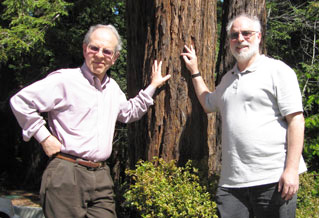Top physicists from around the world will gather at the University of California, Santa Cruz, in January for a symposium in honor of two eminent theoretical physicists on the UCSC faculty: Michael Dine, distinguished professor and chair of the Physics Department, and Howard Haber, professor of physics.
Dine and Haber, who are being honored on the occasion of their 60th birthdays, are both well known for their contributions to the field of theoretical high-energy physics. The symposium, "The Search for Fundamental Physics: Higgs Bosons and Supersymmetry," will take place January 4 to 6, 2013.
"We have managed to put together a really stellar list of speakers for this symposium, and that's because of the reputations of these guys. People want to come and celebrate their careers," said Thomas Banks, professor of physics at UC Santa Cruz, who helped organize the conference.
The symposium comes in the aftermath of exciting developments in high-energy physics at the Large Hadron Collider in Switzerland, where scientists announced in July the discovery of the first solid evidence for the long-sought Higgs boson, a manifestation of the Higgs field thought to give mass to fundamental particles. Haber is particularly well known for his role in developing theories and the attendant phenomenology of the Higgs boson ("phenomenology" involves the application of theory to experiments in high-energy particle physics). Haber coauthored the definitive book on searching for the Higgs boson, The Higgs Hunter's Guide, published in 1989. A fellow of the American Physical Society, Haber received a prestigious Humboldt Research Award in 2009.
"A lot of his work in theoretical physics has emphasized experimental discovery and provides guidelines to the experimentalists in their efforts to discover new things," Banks said. "He is considered a great expert on both the Higgs boson and the search for supersymmetry."
Supersymmetry is a hypothetical symmetry in particle physics that is mathematically elegant but, for now, has very little evidence to support it. Its theoretical properties could help solve certain problems with the Standard Model of particle physics.
Dine has worked on some of the same phenomenological subjects as Haber, including the Higgs boson and supersymmetry. He has also done more theoretical work, making fundamental contributions to superstring theory and quantum field theory. He is the author, with Ian Affleck, of the Affleck-Dine mechanism to explain the asymmetry between matter and anti-matter in the universe. Dine is also known for his theoretical work on a hypothetical particle called the axion, which may account for the mysterious dark matter in the universe.
"Michael has done such an enormous number of things in mathematical and theoretical physics that he's one of the most highly respected people in our field," Banks said.
Dine is a fellow of the American Academy of Arts and Sciences and the American Physical Society. The Division of Physical and Biological Sciences at UCSC honored him with its 2010-11 Outstanding Faculty Award.
Speakers at the symposium will include Nobel laureate David Gross, former director and permanent member of the Kavli Institute for Theoretical Physics at UC Santa Barbara; Nathan Seiberg and Edward Witten from the Institute for Advanced Study in Princeton, N.J.; and Leonard Susskind of Stanford University.
A complete program is available on the symposium web site. The symposium is sponsored by the Santa Cruz Institute for Particle Physics (SCIPP), UC Santa Cruz, the Foundational Questions Institute, and the University of Texas, Austin.



